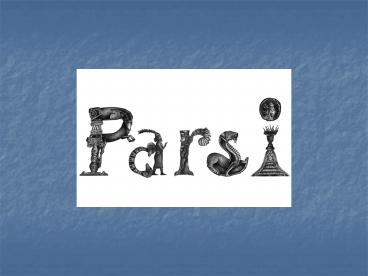Who is a Parsi - PowerPoint PPT Presentation
1 / 21
Title: Who is a Parsi
1
(No Transcript)
2
Who is a Parsi?
- An Indian person whose ancestros came from Pars
- Pars was in Persia (present day Iran)
- The word Persia itself derives from Persis, the
Greek form of Pars. - Farsi is the language spoken by the majority of
Iranians today.
3
Parsis are members of the close-knit Zoroastrian
community and are descendants of people who, in
the 8th century, emigrated to India from Persia
to escape religious persecution.
4
Zoroastrian Religion
- The foundation of the religion is ascribed to the
prophet Zarathushtra, who is commonly known in
the West as Zoroaster, the Greek version of his
name.
He Lived between the 18th and the 6th centuries
BC
5
Zoroastrian (Parsi) beliefs
- The Creator Ahura Mazda
- The Scripture Zend Avesta
- Sun and Fire worship
- Equality of Sexes
- Cleanliness
- Charity
6
A Moral Faith
- According to the faith, a Parsi must actively
resist evil, make a sincere effort to perfect
oneself and, most importantly, promote good in
the world. Placing an emphasis on the
individuals moral responsibility for the good of
the community, Parsis are some of the nations
most generous social citizens.
7
Parsi Fire temples
8
Fire Temples
- Zoroastrians build Fire Temples as places of
worship. There are three grades of Fire Temples
and every house holds a fire altar. - The holiest Fire Temple in India is the Atash
Behram at Udvada, about one hundred miles from
Bombay, where the Sacred Fire brought by Iranian
refuges from Iran has been continuously burning
since 1741. - The earliest Fire temple in India is the Atlash
Behram at Sanjan believed to have been
consecrated around 790AD.
9
Ritual and Prayer
10
Parsi Wedding photo 1940s
11
Community and History
12
Craft Traditions
13
Indian census data (2001) records 69,601 Parsis
in India, with a concentration in and around the
city of Mumbai. There are 5,000 Parsis in
Pakistan. The number of Parsis worldwide is
estimated to be less than 100,000.
14
The Sikhs
- Guru Nanak, founder of Sikhism, received a divine
revelation from God in India in the late
fifteenth and early sixteenth centuries CE.
15
Guru Govind Singh
- Guru Gobind Singh, the tenth and final guru, or
teacher. Guru Gobind Singh created the Khalsa,
the Sikh brotherhood.
16
Signs of the Faith
- Traditionally Sikh men wear five signs of their
faith - Kes - Uncut hair, a sign of faith
- Kirpan - a short dagger symbolizing self-defense
which may be worn in several sizes, even hung in
miniature around the neck - Karha - a steel wristband or bracelet, binding
one symbolically to the truth - Kangha - a wooden comb worn in the hair knot to
show cleanliness - Kacchera - a special undergarment symbolizing
purity - In addition men wear a turban, although it is not
required by the religion.
17
(No Transcript)
18
Worship
19
The Martial Race?
20
Post 9/11 Sikhs
21
(No Transcript)































